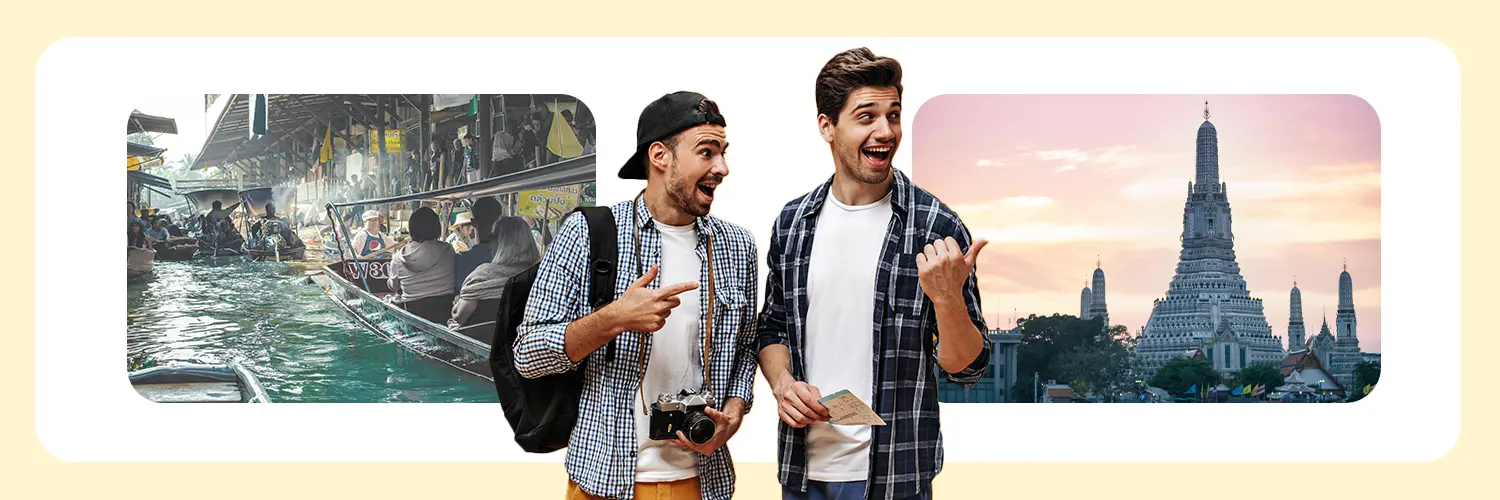
Transportation tips to get around Thailand for Indians
Map Your Thailand Journey: A Travel Guide for an Affordable Thailand Trip for Indians
- Compare rental rates - Prices range from 150-300 THB (INR 354- INR 708) for scooters and 200-600 THB (Approx- INR 472- INR 1,417) for big bikes. Negotiate for discounts on weekly or monthly rentals.
- Avoid leaving the passport - Offer a reasonable cash deposit instead of your passport when renting. You can optimise your island-hopping adventures by referring to a Thailand map featuring the stunning archipelago of Phuket.
- Take bike video - Record a full video while picking up the vehicle, noting any existing damages. This safeguards you from any issues that arise when returning the vehicle.
- Read the contract thoroughly - Understand all rental contract terms and conditions before signing and keep a copy. Calculate your trip to Thailand cost to ensure a budget-friendly and enjoyable journey.
- Return on time - Ensure a timely return to avoid additional charges and do keep in mind to bring back the vehicle to the designated location punctually, with a full fuel tank.
- Inform the agency to extend - Notify the rental agency a few days in advance if you wish to extend the rental duration to avoid penalties. Estimate the overall Thailand trip cost from India, covering flights, accommodation, and other activities.
You can also read: Thailand travel guidelines: Let’s Go Get Some Thai
Bus Transport in Thailand
Buses provide a reliable and affordable transport option to travel around cities and between Thailand destinations. Additionally, if you have a reliable Thailand map handy, you are ready to traverse through the picturesque landscapes of Thailand like a local.
For public bus services within a city, you can easily find routes and schedules at local tourist information centres or you can simply ask your hotel staff. Local buses have route maps and stops marked in English, making them easy for tourists to navigate.
How to Find the Local Bus Routes
- Google Maps: This application ensures detailed route planning and transit directions for bus services across the majority of major cities and tourist destinations acting as a significant Thailand trip planner. It covers all the local bus routes in nearly every location a visitor might explore
- Tourist Information Centers: These offices have printed maps, schedules, and directions for local transportation options, including buses. They can advise on routes serving key attractions.
- Other apps: While Google Maps likely has the best coverage, apps like Transit, Moovit, and Rome2Rio allow route planning for Thai buses. These could serve as valuable alternatives to Google Maps in certain situations
Booking and Payment Guidelines for Bus Travel in Thailand
- Tickets for nearly all buses are available for direct purchase at the station shortly before departure. It is advisable to queue early to ensure ticket availability.
- Bus tickets can be obtained in advance through Thai travel agencies with minimal commissions.
- Prices range from around 100-500 THB (INR.237- INR.1,185 ) per person depending on route length and bus class.
- Point to note: A few bus companies allow online reservations, though most operators do not have booking websites.
There are numerous payment alternatives, extending from credit cards to cash, that contributes to a smooth and hassle- free payment experience:
- International cards from India: Major credit cards are accepted for buying tickets at many bus stations in Thailand. This offers a convenient payment option for travellers from India and other countries.
- Travel cards: Simplify your Bangkok commute with a Niyo Card – this lets you effortlessly tap your way through metro and bus fares, eliminating the need for loose change. Both the BTS SkyTrain and MRT subway readily accept this convenient payment method.
- Cash to the driver: When hopping on local Thai buses, pay the fare directly to the driver in cash.
- Other means: Certain bus companies offer the convenience of online booking and advance payment options for long-distance journeys, but in-city buses typically operate on a pay-on-board basis without reservations.
Discover the Pros of Bus Travel in Thailand
Public buses are renowned in Thailand for their affordability, making long-distance travel accessible with reasonable fares. Ideal for budget-conscious travellers, local city buses offer convenient direct ticket purchases, covering an extensive network of destinations.
Additionally, you get to choose from various classes, including
- Ordinary class
- Second class
- First Class
- VIP
While second-class buses provide spacious seating, first-class and VIP options elevate the experience with reclining seats, snacks, and entertainment, albeit at a higher cost. The extensive network ensures convenient travel across both local and long-distance routes.
Inter-city buses facilitate convenient travel between cities and access to renowned tourist destinations across Thailand. Strategically positioned in city centres, major bus stations serve as pivotal hubs for efficient and comfortable journeys. These can also be included in Thailand vacation packages sometimes.
Ways to Locate the Bus Routes
- Google Maps - Google Maps provides comprehensive transit directions and route planning for intercity buses in Thailand. It acts like a Thailand Map helping you navigate your ways.
- Tourist Information Centres - Visit local tourist information centres across Thailand to get bus schedules, maps, and advice on routes serving key destinations.
- Central Bus Stations - Major bus stations are in Bangkok, Chiang Mai, Phuket, Pattaya and other popular places.
- Other Apps - Apps like 12Go Asia, Busonlineticket, and GoEuro offer convenient options to explore Thailand’s bus routes and facilitate easy ticket bookings.
Booking and Payment Process
- Websites to Buy Tickets - Major bus companies like Sombat Tour, Nakhonchai Air, and Green Bus offer online ticket bookings and payments on their sites.
- Pay with International Cards - Many bus companies facilitate online payments through Visa and Mastercard, though additional charges may apply.
- Transport Cards - Thailand does not have local multi-transit cards. Payment options differ across regions.
- Cash at Station - Cash in local Thai Baht can be used to buy tickets at most bus station counters across Thailand.
Common Places to Travel via Bus in Thailand:
- Bangkok to Phuket Distance: When planning your journey from Bangkok to Phuket by bus, you can find this route conveniently covered by various bus services. The bus journey typically takes approximately 12-13 hours, depending on traffic and specific routes.
- Bangkok to Pattaya Distance: Traveling from Bangkok to Pattaya by bus is a popular and convenient option. The bus journey usually takes around 2-3 hours, depending on the specific route and traffic conditions.
- Bangkok to Chiang Distance: The travel time from Bangkok to Chiang by bus typically ranges from 9 to 11 hours. Keep in mind that travel times can vary, and it’s advisable to check with the bus company for the most accurate and up-to-date information on schedules and journey duration.
Things to keep in mind
- Have small bills ready to pay fares when boarding local buses
- Watch your valuables; bus theft, unfortunately, happens
- Motion sickness medication if needed – some roads are winding
- Allow extra travel time as schedules may not be strictly followed
![]()
In a Nutshell
Thailand offers a budget-friendly and extensive network for both local and long-distance journeys, providing flexibility in terms of routes and payment methods. You can easily travel from Bangkok to Pattaya by bus or Bangkok to Phuket or from Bangkok to Chiang very comfortably.
To find local bus routes, you can use Google Maps, visit Tourist Information Centers, or explore alternative apps Tickets can be purchased directly at the station or in advance through travel agencies, with prices ranging from INR 100-500 THB per person. Payment methods include international cards, travel cards, cash to the driver, and online options for some long-distance journeys.
In-city buses also have extensive networks and come with different classes such as Ordinary, Second Class, First Class, and VIP that cater to various preferences.
Shared Taxi Services in Thailand
Shared taxis offer a flexible and fast transport choice to reach your destination in Thailand. Explore a variety of Thai car rental services that are especially useful for places that are not well connected by railway networks or bus routes.
How to Book and Pricings
Share-taxis, known as “songthaews”,a type of Thai car rental service can be flagged down on streets or booked at taxi stands across Thailand.
You can flag down shared taxis on the street or coordinate them through your hotel. The expected fares for shared taxis are:
Tuk-tuks – 60-100 THB (INR 141- INR 236) for short city journeys
Songthaews – 20-40 THB (INR 47- INR 94) per person for local trips
Minivans – 500-800 THB (INR 1,181- INR 1,890) for a 5-6 hour intercity journey
The Grab app allows booking Songthaews with upfront pricing in some parts of Bangkok, Phuket, and Chiang Mai.
However, the majority still prefer to hail shared taxis directly on the street over any Thai car rental services.
Type of taxis
- Rot tuu – These are pickup trucks with two-facing rows seating up to 12 people in an open back. Rot tuus is commonly used for short journeys within a town or city and for rural travel. A comprehensive Thailand map assists adventurers in finding their way to the serene waterfalls and hot springs in Erawan National Park.
- Tuk-tuks – These are three-wheeled auto-rickshaws that offer convenient transportation with seating for 3-4 passengers, making them an ideal choice for quick navigation within city neighbourhoods and markets.
- Samlors – These are bicycle rickshaws, typically with a covered passenger seat, that are ideal for short trips in old town areas of Bangkok, Chiang Mai and other tourist cities. Very convenient for sightseeing. Experience the beauty of island hopping with a Thailand Map, helping you to explore the enchanting landscapes of Thailand.
- Songthaews – Songthaews are larger pickup trucks with two-facing benches installed on the back to seat around 20 passengers. Songthaews are found across cities and towns in Thailand.
- Minivans/Mini-buses – These Toyota Commuter vans have 8-10 passengers seating and usually have air conditioning. Minivans are popular for longer intercity journeys spanning 5-6 hours between cities.
Things to keep in mind
- You can hail rot tuus, tuk-tuks and songthaews on the street. Or ask your hotel to arrange a shared taxi ride to a destination.
- When sharing a ride, be prepared for stops to pick up and drop other passengers.
- Establish the fare beforehand and have the exact change ready to avoid haggling and overcharging. Overall, shared taxis provide a fun way to travel like the locals!
- Whether you are trekking in the mountains or relaxing on the southern beaches, a Thailand map is your trusty companion for an enriching journey. Enhance your travel experience with a comprehensive Thailand travel guide, offering insights into culture, attractions, and local tips.
- You can also explore the Thailand trip package from India that plans your travels and pre-books car rental services for an easy commute.
You can also read: Enjoy the best trekking in Thailand with a comprehensive guide!
Boats and Ferries in Thailand
Travelers can efficiently plan their transportation routes from Bangkok to Ayutthaya using a Thailand map with major highways and rail lines.Exploring the tropical islands and coastal wonders of Thailand in a boat takes you on a journey filled with joyous adventure.
- Phuket to Krabi, Koh Phi Phi, Koh Lanta
- Krabi to Koh Lanta, Koh Phi Phi, Railay Beach
- Koh Samui to Koh Phangan, Koh Tao
- Bangkok to Pattaya
Booking Boats and Ferries in Thailand: What You Need to Know
You can purchase ferry tickets at pier counters or book in advance through sites like 12Go Asia, PhuketFerry, and Lomprayah. Ferries range from high-speed catamarans to basic slow boats. Prices start from 300 THB (Rs.708) for short island hops. Plan your perfect getaway with a Thailand trip guide, ensuring you get all of the country’s incredible experiences.
Opt for ferries in Thailand during the daytime to enjoy ocean views. Keep motion sickness medication ready if prone to it. Also, wear a lifejacket, follow crew instructions and avoid overcrowded boats for safety.
Things to keep in mind while riding a ferry
- Reconfirm your departure time and pier number before heading to port. Arrive 30-60 minutes early during peak season.
- Purchase tickets at ferry piers to get assigned seat numbers and boarding passes..
- Carry medication if prone to seasickness during choppy rides.
Other Transport Rentals
Car Rentals
Explore Thailand with ease using Thai car rental services for a hassle-free adventure. Renting a car in Thailand with a driver or self-drive gives flexibility to roam around Thailand’s islands, beaches and national parks. Leading car rental companies in Thailand like Avis, Hertz, and Sixt have outlets across Thailand. Local agencies like Phuket Car Rent and Thai Rent a Car also offer competitive rates.
Navigating the intricate canal systems of Bangkok’s old town is simplified with the assistance of a detailed and accurate Thailand map. Expect to pay around 800 – 1500 THB (Rs.1,890- Rs.3,545) per day for a small sedan.
Top places to visit:
Hiring a car rental service in Thailand lets you explore many places at your convenience. Here are some of the top 10 places you can see around Thailand:
- Doi Inthanon National Park:, Elephant Nature Park, Old City Walls and Gates are some of the iconic sites you can see in Chiang Mai.
- Grand Palace, Jim Thompson House, Bangkok National Museum, MBK Center, are one of the top 10 places you can explore in Bangkok.
- You can also easily explore Patong Beach, Phi Phi Islands, Bangla Road when you hire a car rental service in Phuket.
Cycle Rentals
Many hotels and shops rent out bicycles, which is ideal for touring around beach towns or scenic routes. Opt for sturdy mountain bikes if planning hilly rides. Rental rates are 100-300 THB (INR 236- INR 708) per day. Learn the different transportation options and choose the most suitable one for how to go to Pattaya from Bangkok. Don’t forget to take assistance from a Thailand Map to navigate through the streets of Thailand comfortably.
Electric Scooter/Bike Rentals
An eco-friendly and fun way to go sightseeing is by renting e-scooters or e-bikes, which many providers like Rebikes, Green Momentum, and Eco Bike offer in major tourist cities. Prices start from 200 THB (INR 472) for an hour’s rental. Helmet and basic riding instructions are provided. From the urban sprawl of Bangkok to the serene landscapes of Pai, a Thailand map ensures you make the most of your travel experiences in this diverse and enchanting country.
Travel around Thailand like a pro. Get your travel forex card now for hassle-free transport!
Get Insurance Now!Scan QR Code To Download The App

Key Takeaways
- Exploring Thailand on two wheels with reliable scooter rentals from trusted brands can ensure a smooth ride. This includes comparing rental rates, avoiding passport surrender, recording the vehicle’s condition, reading contracts, returning on time, and informing the agency about extensions.
- Discover Thailand’s cities and landscapes with affordable and reliable buses. Use Google Maps or apps like Transit and Moovit for routes and buy tickets at stations or through agencies (INR 100-500). Payments are easy with international cards, travel cards, cash, or online bookings.
- Efficiently travel across Thailand with versatile “songthaews’’ shared taxis. Ideal for less-connected areas, these can be hailed on streets or booked through your hotel.
- You can also opt for an eco-friendly mode of transport in Thailand by choosing bicycles. Additionally, you can look for ferries and boats in Thailand as your alternative mode of transportation.
Frequently Asked Questions
1. Where are intercity bus terminals located?
Major bus stations are located in the city centres. Bangkok has three main bus stations – Northern Bus Terminal (Mo Chit), Southern Bus Terminal and Eastern Bus Terminal. Choose from a variety of to tailor your trip to your preferences.
2. What is the cheapest way to travel between Bangkok, Pattaya and Phuket?
Buses are the most economical transport option. A bus from Bangkok to Pattaya (2.5 hours) costs around 120 THB (INR 283), while Bangkok to Phuket (12 hours) costs INR 600-800.
3. Is it safe for female travellers to use shared taxis at night?
Avoid taking shared taxis alone late at night. Opt for metered taxis or registered services like Grab at night for safety. During the day, shared taxis are generally safe. Navigate the Thai rail network with ease using a Thailand train map, showcasing the extensive rail connections across the country.
4. What is the best way to pay for public transport in Bangkok?
Get a Rabbit Card stored-value card for convenient cashless payments on BTS, MRT, buses and ferries in Bangkok. Just tap the card when boarding. Discover the charm of island-hopping with ferries in Thailand, connecting various coastal destinations.
5. Which taxi apps are recommended for getting around Thai cities?
Try Grab, Bolt and Gett Taxi apps. They offer affordable rides with e-payments. Useful in Bangkok, Phuket, Chiang Mai, etc.







